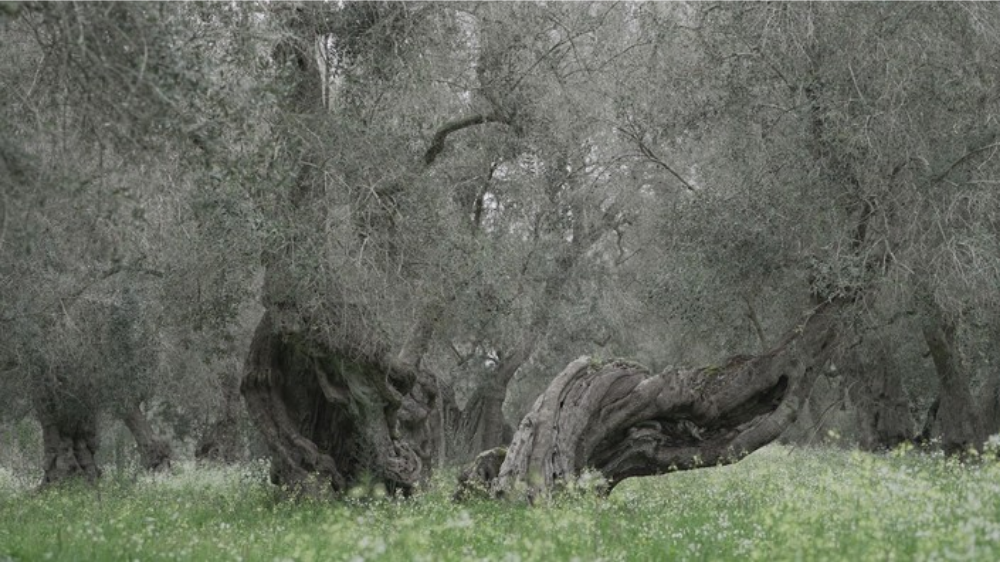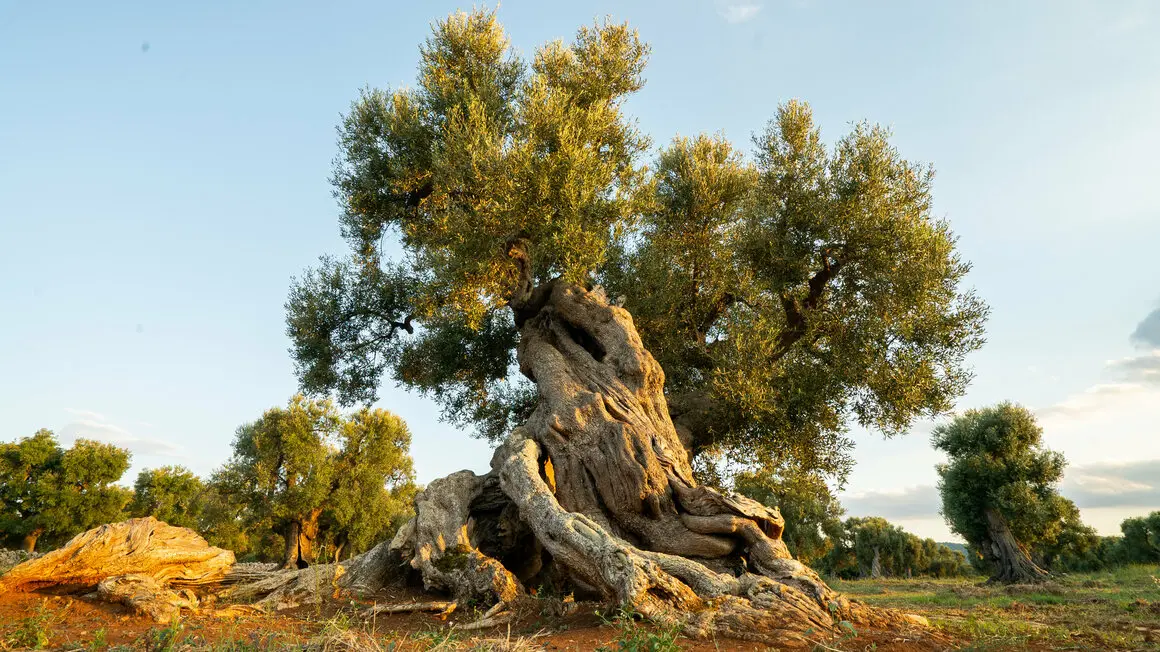
On a cool night, in April 2018, my then 23-year-old brother, Stefano Petroni, drove a rusty camper into one of Puglia’s oldest olive fields. He killed the headlights and moved slowly through the trees, their ancient silhouettes outlined by a bright moon. The historic olive groves, once loud with the singing of leaves in the wind, were leafless and silent.
Stefano had come with several accomplices, and they had little time to fulfill their mission. The crew reached a wide opening in the field, where the waist-tall grass indicated the extent of abandonment by the landowner. In front of them a massive olive tree, its knotted trunk gnarled like flexed muscles, held up thick branches. Just above the intertwined roots, the tree trunk housed a dark cavity with enough room for three people: a secret space where locals had met for centuries to pray, meditate, and make love. This living monument, some 1,000 years old, was known as Albero Della Chiesa, the Church Tree. Locals say that its olives were once used to make oil for the priests of the area, who used it for holy sacraments. But now, it was dying.

As a nonprofit journalism organization, we depend on your support to fund more than 170 reporting projects every year on critical global and local issues. Donate any amount today to become a Pulitzer Center Champion and receive exclusive benefits!
Xylella fastidiosa, a bacteria that kills plants by obstructing nutrients and water from flowing through their vascular tissues, has plagued vegetation in countries around the world. Today, different strains of Xylella affect 563 plant species worldwide: peaches in Argentina, pears in Taiwan, oranges in Brazil. When Xylella enters a new territory, it can trigger an agricultural and ecological apocalypse if not quickly contained.
Southeastern Italy’s Puglia region produces 12 percent of the world’s olive oil. But since Xylella was first discovered in the region in 2013 — widely thought to have arrived on plants imported from Latin America some years earlier — the disease it causes, known as Olive Quick Decline Syndrome, has decimated the industry. In less than a decade, the bacteria has infected at least one-third of the region’s 60 million olive trees and spread across 750,000 hectares of land, endangering thousands of family businesses. A million trees have already been uprooted, and olive oil production has declined drastically: During the 2019 harvest, Salento produced only 5,295 metric tons of olive oil, a 90 percent decrease compared to historic levels. In Salento, the lower part of Puglia that forms the heel of Italy’s “boot,” dead olive trees fill the horizon as far as the eye can see.
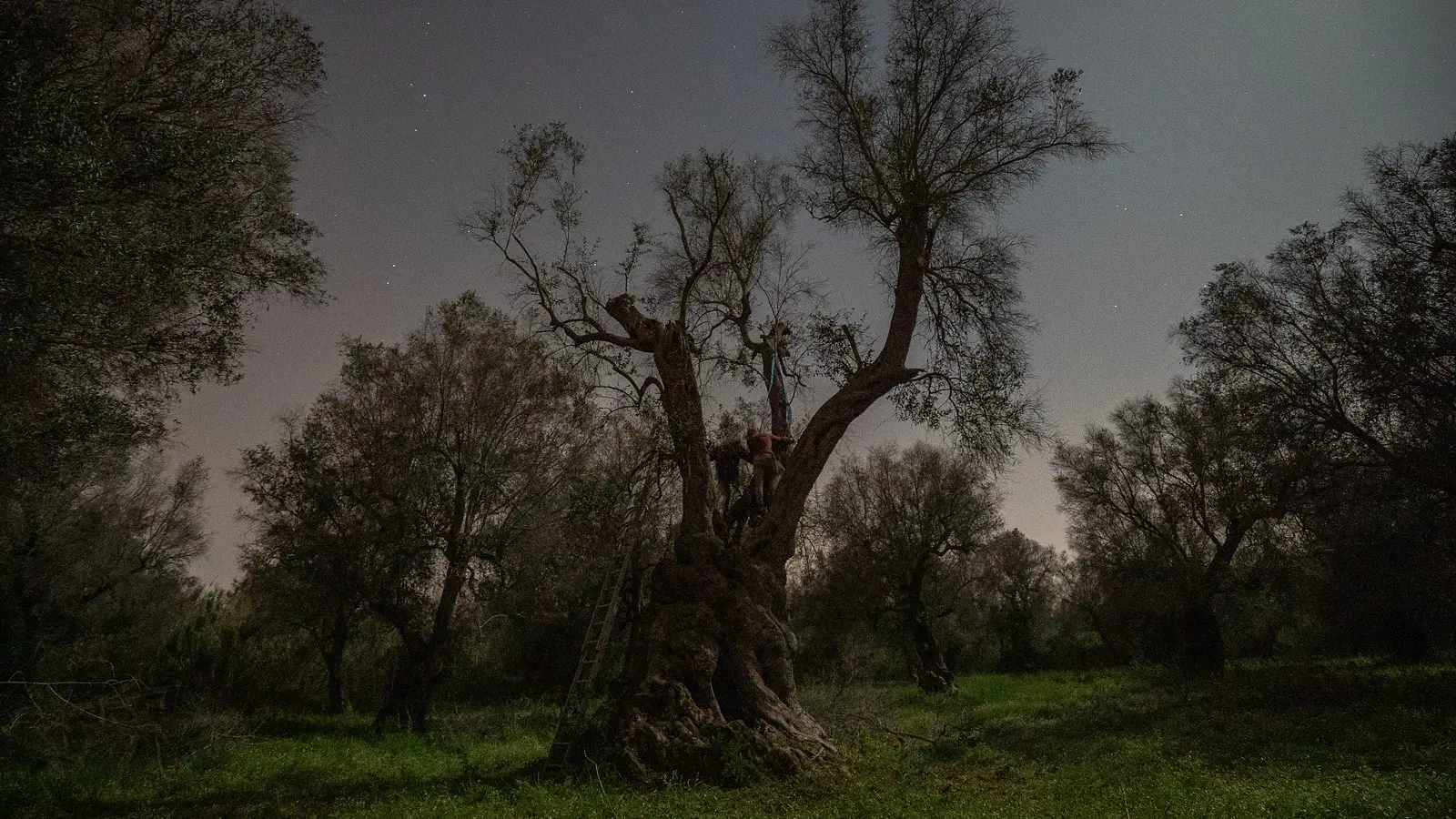
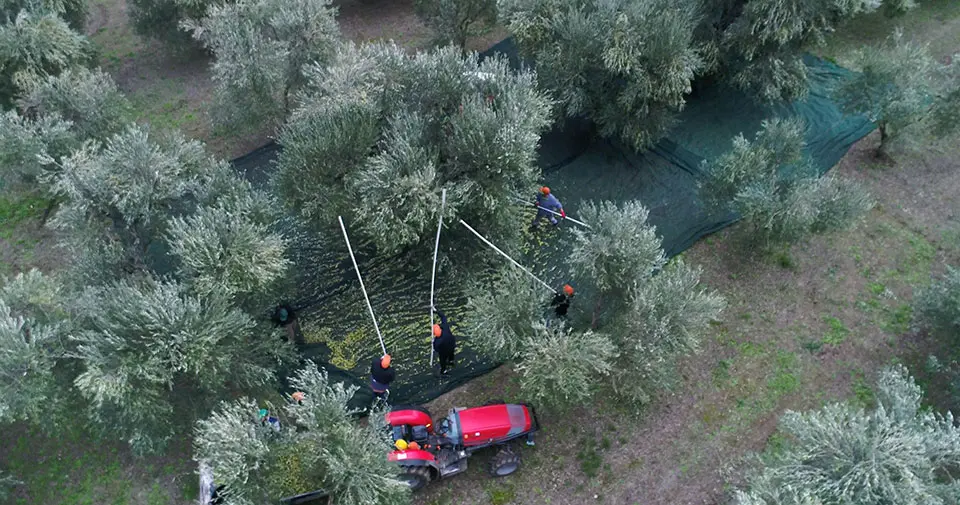
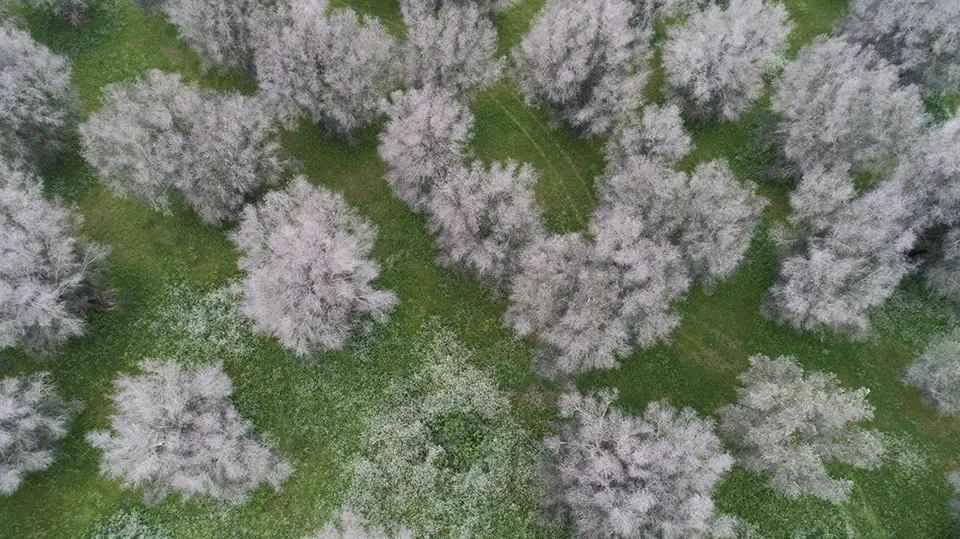
By the time we discovered that the Church Tree was infected with the disease in 2017, that area of Puglia had been overcome with the bacteria and the battlefront had moved to northern Puglia, where it was fast approaching my own family’s olive fields. However, scientists had just discovered a way to preserve older infected trees through grafting. Stefano and I rallied a group of entrepreneurs (including our own father) and begged the owner of the Church Tree to save the dying giant using this method. But the owner said that the best thing she could do to protect the tree was “not to do anything at all.” Like many others in the region, she had succumbed to anti-science conspiracy theories about the diseased trees and did not believe the bacteria existed.
“I think the owner was only scared of losing the wood,” Stefano says skeptically. (Nowadays, millions of dead olive trees are sold for their wood at a mere 50 euros per ton. Much of this ancient wood ends up burning in brick ovens for pizza.)
Stefano decided that he had to act. Discussions turned into heated arguments when my father and I tried to convince him that we could do little without the owner’s permission. He could not be persuaded. Finally, one day in April 2018, he announced he was heading south with a team of grafters to save the tree. That night, when Stefano silently drove to the Church Tree and carefully unloaded a long ladder from the camper so he could reach its upper branches, I was secretly proud of him. He was doing whatever it took to save Puglia’s olive-growing tradition and our sacred trees.
Olive tree cultivation dates back millennia. The Cretans and Philistines first domesticated wild olive trees in Greece and the Middle East about 6,000 years ago during the Bronze Age. The Greeks widened cultivation to Southern Italy some 3,000 years after that, and later on, the Romans, who valued olive oil as a commercial item more prized than wine, helped spread its use from Spain to Northern Africa through their trade and conquests. Approximately two millennia ago, the ancient Romans arrived in what would become Puglia and planted millions of olive trees. Dry summers and rainy winters made the Mediterranean the perfect place for the olive tree to thrive. Today, an estimated 1,000 different olive cultivars grow worldwide, dozens of them in Puglia.
In Puglia, the olive tree is a part of the family. Trees are inherited from previous generations as ornaments for country houses or core crops for agricultural fields. During Sundays and holidays, groups of friends gather between these trees for bring-and-share lunches. Children build fortresses on their branches, while their shade offers cover for romances and funeral wakes alike. The trees are so embedded into the culture that people see human faces in the knots of ancient trunks. The marvelous twists and turns of the trunks, in turn, reflect the work of generations of men and women who have carefully cut away dead branches, sawed away diseased sections, and cauterized fresh cuts with fire (the slupatura technique). The olive tree’s titanic ability to survive burns, cuts, droughts, and frosts makes it, in the minds of many, immortal. Indeed, the average olive tree lives 500 years, and some can live well past 1,000 years.
The autumn olive harvest is the long-awaited celebration of a year’s patience. Cities wake up in unison before sunrise. Three-wheeled cars roar down dark roads towards the countryside. The winter morning dew wets shoes while a humid fog pierces clothes and freezes bones. Harvesters stand around a fire lit with olive wood and heat up bread, on top of which they smash soft black olives — a burst of energy before the hours of work shaking olives from the branches into the nets laid below the trees.
The trees are so embedded in the Puglian culture that a local proverb says: L’oiu te ulia lu male porta via — “Olive oil will take away all evil.” But when the Xylella arrived, it turned olive oil into a victim, instead of a savior. And no one was ready to believe that these seemingly eternal trees were dying.
In May 2014, Alexander Purcell, 77, an entomologist at the University of California, Berkeley and an expert on Xylella fastidiosa, was driving through an infected olive orchard in Salento when he spotted a spittlebug moving back and forth on the windshield. He opened the window and waved the bug out of the car.
“Did you see how easy that was?” he said to Giovanni Martelli and Donato Boscia, the Italian scientists from the Consiglio Nazionale delle Ricerche (National Research Council or CNR), Italy’s largest public research institution, who were accompanying him. Purcell was referring to the fact that it took only half an hour within a Puglian olive grove to spot the culprit for the spread of Olive Quick Decline Syndrome and discover how it had hitchhiked its way to new and healthy groves.
Giovanni Martelli, who passed away last year, was a plant virologist who for decades led the research of viruses and virus-like diseases of Mediterranean crops. He was the first scientist to note that the symptoms olive trees showed in Puglia resembled those caused by Xylella, which had never been detected on olives before. He ran some tests, and in 2013 proved his observations right.
Xylella is one of the fiercest plant pathogens known to man. It survives in the veins of trees (xylem) and insects’ mouths. Today, Puglian growers fear the spittlebug (Philaenus spumarius), a widespread insect once believed to be harmless but now known to spread the bacteria. When a spittlebug feeds on an infected leaf, the bacteria find a new home within the bug’s maws. When it later feeds on another tree, it transmits the bacteria.
When Xylella infects an olive tree, it forms a biofilm in the xylem, blocking the water from flowing. Bacteria multiplication also triggers short circuits in the defensive system of the plant: Most olive varieties react violently, causing hydric stress and death. Symptoms appear about 18 months after initial infection: Leaves turn brown, and the plant dries from the outside in, at a speed of two inches per month. By the time a plant shows the first symptoms, it has only a couple of years left to live.
The repercussions extend beyond those on the economy and culture. Loss of foliage associated with dead trees is expected to increase temperatures and decrease precipitation locally. The loss of canopy cover, meanwhile, impacts plants and animals that thrive in the shade the olive trees provided, while also contributing to desertification. Though olives remain the most high-profile victim, the bacteria have also infected dozens of other plants in the region, including crops like almonds and cherries, and ornamental plants like oleander and lavender.
Purcell saw this all coming. Xylella was first detected in the 1880s when Pierce’s Disease (caused by a Xylella subspecies) wiped out Southern California vineyards. For the next century, outbreaks were confined to the Americas. But in 1988, Purcell created a hand-drawn map of the world predicting where Xylella would spread next, and it turned out to be extremely accurate. Mild winters and an abundance of vectors made the Mediterranean the perfect place for Xylella to thrive. Purcell warned the European Union that a lax attitude towards plant quarantine could mean great danger, but his warnings went unheeded.
There is no cure for Xylella, but there are examples of containment. Pierfederico La Notte, a plant epidemiologist at CNR’s branch in Bari who worked closely with Martelli, points to California as a prime example of quick intervention. “They had several epidemic waves, and the territory reacted strongly and in a united manner,” La Notte told me. In the 1990s a new invasive vector, a glassy-winged sharpshooter, was found to spread Xylella in the Golden State. Landowners asked scientists for help and provided funds for the research. And after only two years, farmers were able to stop the spread of the bacteria thanks to short-term pesticide spraying. Though insects can develop chemical resistance over time, the intervention gave farmers the chance to control the infection before it spread, though they deal with it to this day.
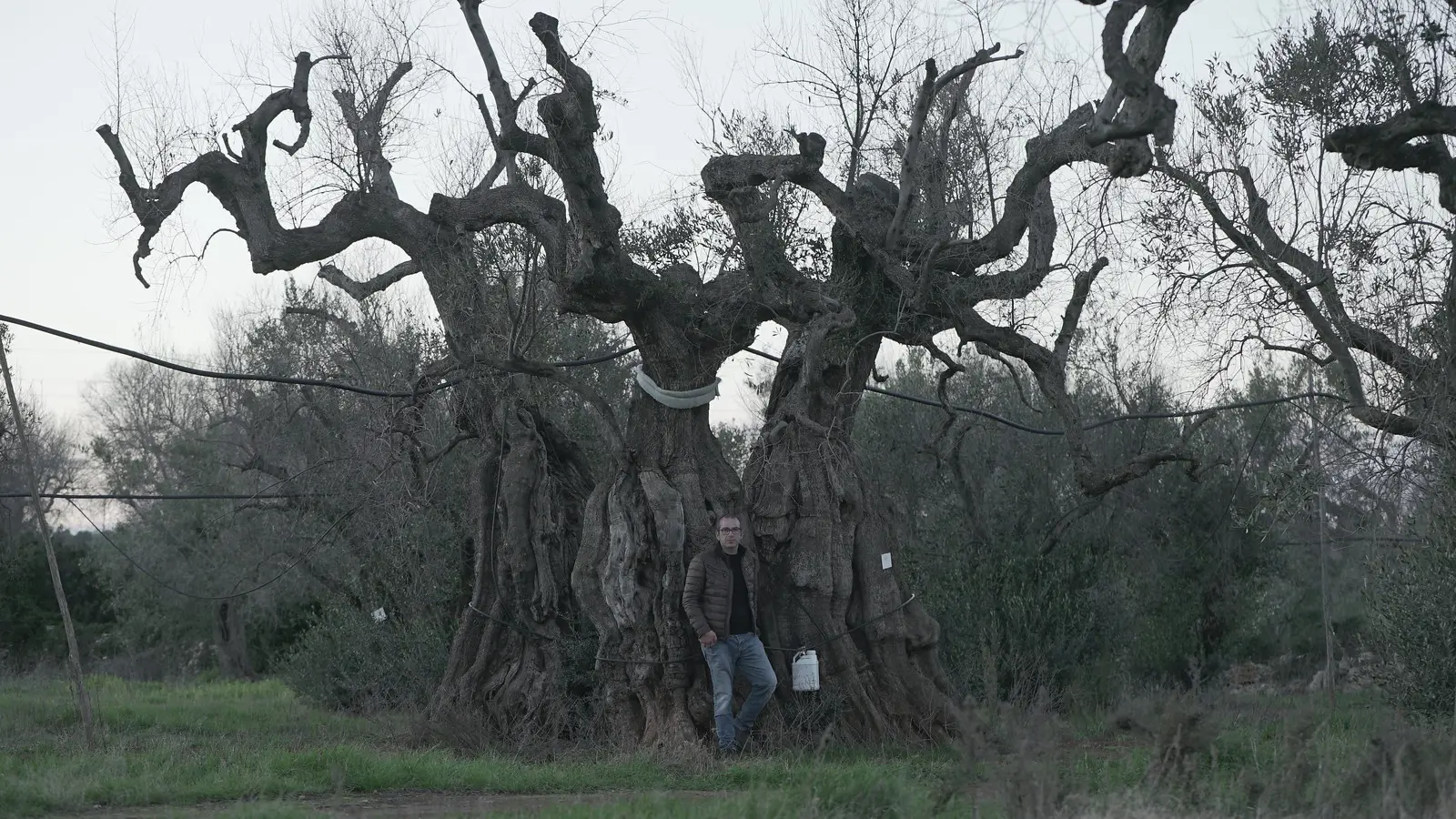
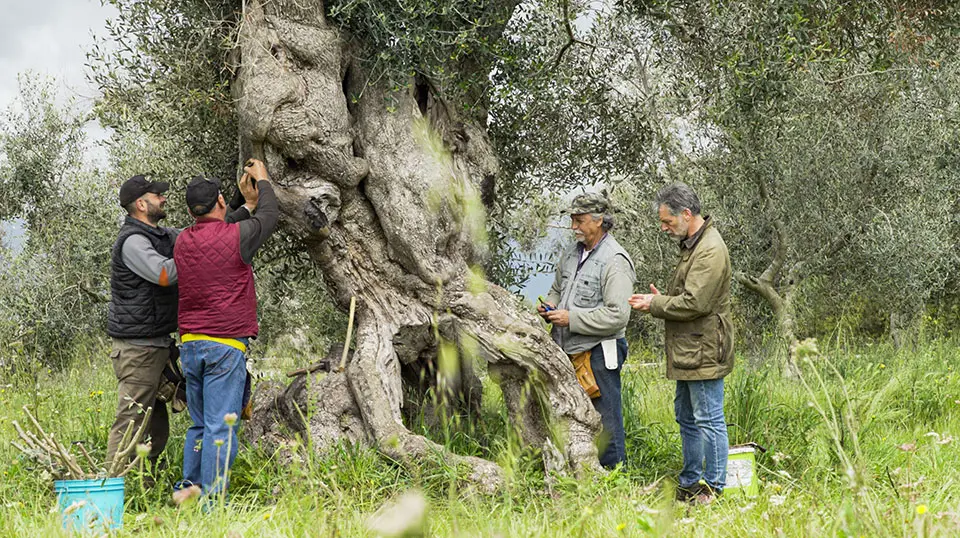
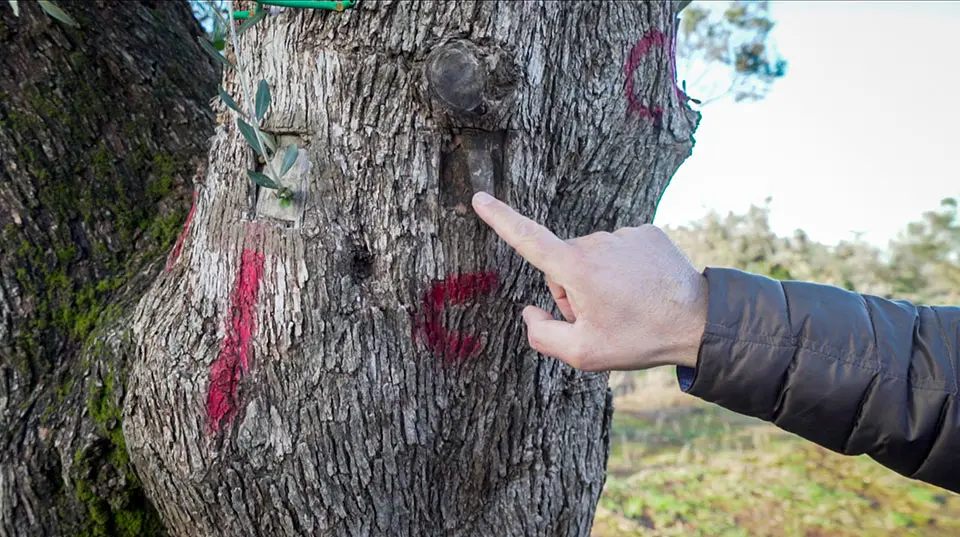
La Notte wanted the same kind of cooperation to happen in Puglia and spent countless days educating Puglians on the threats of Xylella when it was first discovered there. He wasn’t alone. As soon as Xylella appeared, the European Union gave Italy directives to prevent its spread. In 2015 the Italian government gave full powers to a military-police general, Giuseppe Silletti, to act, calling for creation of a national emergency plan (usually crafted for earthquakes), and charging him to diagnose, seize, and remove 3,000 infected trees.
The international community was worried, yet Puglians were not. “It’s a strange phenomenon of presbyopia (the loss of the eye’s ability to focus on nearby objects). From the outside, people see the situation more clearly than here,” La Notte told me recently.
Instead of asking scientists to intervene, a distinctly anti-science movement took root in Southern Italy. Groups of Puglians warned Purcell, whom they accused of spreading lies, never to come back to the region. A group known as Popolo degli Ulivi (People of the Olives) organized protests against the emergency Xylella plan and spread misinformation about the diseased trees on the web. In 2015, Puglia’s newly elected governor, Michele Emiliano, along with several members of the populist Five Star Movement party, attempted to garner political support by propagating conspiracy theories about what was causing olive tree deaths.
The theories were far ranging. Cristian Casilli, a Five Star Movement regional counselor, blamed multinationals for the death of the olive trees. Nandu Popu, leader of the popular music band Sud Sound System, appeared in a video blaming Monsanto for the disaster. “Some politicians want to eradicate our olive trees, and they want to replace them with Monsanto GMOs,” Popu said. He added that the new GMO trees were in Israel and ready to be shipped to Puglia, despite the fact that there are no genetically engineered olives, and Israel had no such trees. Longtime politician Adriana Poli Bortone went as far as saying that chemtrails caused the disease’s spread.
Marilù Mastrogiovanni, a local journalist, attributed the trees’ demise to common pests like wood-eating worms and fungi. She wrote about how local politicians were pushing for the tree’s eradication to let the Mafia and real estate businesses develop the land, and to let large agribusinesses plant patented trees. “I would call this land-grabbing,” she told me.
These varied fantastical theories inundated social media and found a platform in national newspapers like Il Fatto Quotidiano.
The intense propagation of this misinformation drove people to the street. Panic spread when General Silletti started enforcing the removal of infected trees. Rage mounted, and local farmers and environmentalists formed human chains around infected trees to stop eradications. The anti-science movement gained so much momentum that in early 2016 Governor Emiliano dismissed the Xylella task force created by Silletti outright, calling his plan “devastating.”
“The olive is a particular plant for us,” he said at a conference. “You cannot uproot it and regrow it in 20 years. The cycle of this plant is hundreds of years.”
He maintained that it was useless to cut the trees to contain the disease, and pushed back against the EU and the Italian government, stating that they could not tell Puglians what to do. The movement reached its peak when government prosecutors from the city of Lecce, in December 2015, started an investigation into more than a dozen prominent scientists and governmental figures, including General Silletti, who had been working to address the issue. They stood accused of spreading the disease across Puglia.
“Crazy! It’s like shooting yourself in the foot,” Purcell said of the investigation. Notebooks, computers, and research material were seized, and research and containment efforts stopped at a critical moment when there was still some hope to stop the spread of the disease. Governor Emiliano hailed the trial against the scientists as a liberation.
The investigation was dismissed in 2019, and all accusations were dropped. But by then it was too late for southern Puglia. Officials had declared the region lost and the eradication efforts there had stopped. Xylella was spreading north.
It’s hard to understand why such far-fetched theories took root. Some, like Gian Andrea Pagnoni, an environmental science professor at Ferrara University, suggest it’s because Puglia has always been a land of conquest. Several invaders exploited Southern Italy over the centuries: Greeks, Romans, Byzantines, Swabians, Bourbons, Saracens, as well as the Savoia — who in 1861 unified Italy, incorporating the south at the servitude of a northern monarchy. As a result, Puglians feel they are on their own and are entitled to defend themselves. “An engraved memory of distrust towards institutions played a crucial role” in the unchecked spread of the bacteria, Professor Pagnoni told me.
Others point to the deep tradition of olive growing in the region. Some locals may simply have been unable to come to terms with the idea that their culture was at risk, and that the solution was uprooting centuries-old trees.
“Nobody could expect the cultural reaction to this disease,” Purcell added. “People believe in what they want to believe. Once you choose your belief, it’s difficult, almost impossible, to change it.”
The disease is now fast spreading north in the flatlands of Ostuni and Savelletri, where millions of monumental olive trees face possible death. My father has started to graft his older trees to prepare for the illness, which is currently some 60 km away.
Researchers, meanwhile, continue with their battle to save the trees. Some are working to find resistant olive varieties that could be used to replant areas where everything is lost. The Italian and European Union governments continue the push to control the bacteria, which endangers Southern Europe’s multibillion dollar olive oil industry. While they no longer hope to eradicate Xylella in southern Puglia, they hope to contain it. They are expanding monitoring operations to detect the bacteria before trees show outward signs of ill health and working to remove infected trees more quickly to maintain a buffer between infected and uninfected territories. Thankfully, many conspiracy theorists in Puglia have since been persuaded by the science, which facilitates these containment efforts.
But all this work takes time and resources. Which, unfortunately, means that many of the region’s ancient olive trees, including some that have stood for more than a thousand years, will be impossible to save.
Last year, I asked Stefano why he had been so fixated on saving the Church Tree. “I couldn’t stand the idea that the Church Tree could die,” he replied, breaking into tears. To him, the old tree felt like a being he had a personal connection with. “It had become like my grandparent,” he explained. Indeed, he had become so involved with the idea of saving the tree back then that after the grafting attempt he had tattooed a likeness, a tree half-dead and half-alive, on his sternum: A plant skeleton spreads over his left side; robust limbs reach out on his right. He had believed that if he acted fast, he could save it. “I had seen the results of the grafting technique, and I thought there was hope,” he told me.
Stefano had been inspired by the work of Giovanni Melcarne, an agronomist from the Puglian town of Gagliano del Capo. In partnership with the CNR, Melcarne leads the field research to find Xylella-resistant, local olive varieties. He believes he has found a promising candidate that would add to the two other known resistant varieties.
Melcarne realized early on that grafting could save the ancient trees: If the branches of a vulnerable or diseased tree were replaced with those of a resistant variety, the tree might live. Because grafting is not an exact science, the technique was not an instant success when Melcarne began experimenting with it: Grafted trees suffered parasite attacks and needed constant supervision and humidity. Melcarne soon understood that the healthier the plant at the start, the better grafts would work. Today, he’s the go-to man for desperate olive growers and receives countless requests to help save old trees. He’s also the man my brother went to for advice.
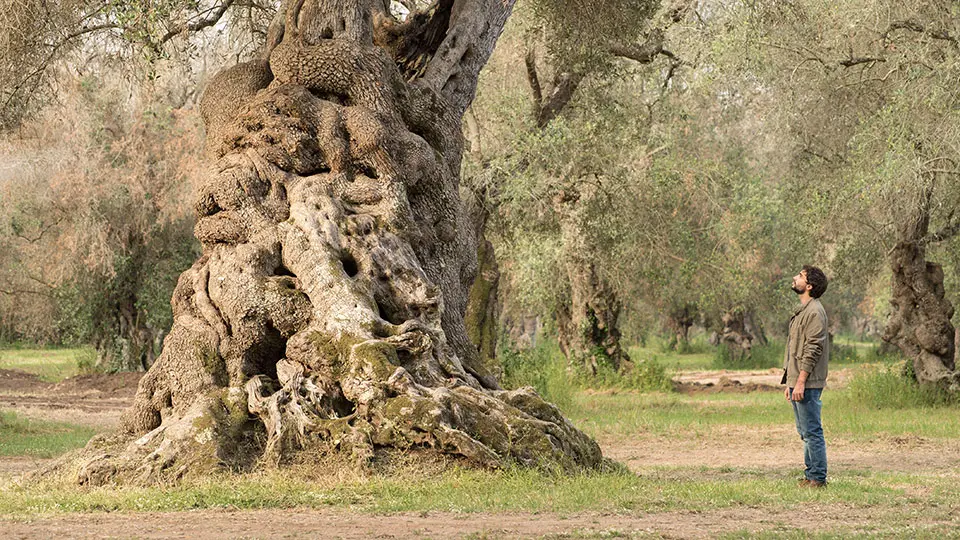
But grafting is not a cure. “You have to distinguish two aspects: co-living in the infected area and stopping the advancement of the epidemic,” says CNR epidemiologist La Notte. The grafting technique can save some of the oldest trees, but can’t save whole orchards or stop Xylella’s spread, he says.
Still, it offered Stefano, and me as well, a spark of hope. That April night, Stefano and his friends worked until sunrise, inserting 25 grafts on the Church Tree. “We wanted to save them all, and it was tough to choose,” Stefano recalled, referring to all the other trees in the field. “But it felt like a victory. We had saved it. It was going to live.”
Melcarne was not as optimistic. He had seen the advanced infection stage of the Church Tree. “That plant had no hope,” he told me later. He didn’t only fear the state of the tree, but also the disease deniers: Grafts, too, were the target of the anti-science movements. A few years earlier, somebody had broken into his experimental field and snapped several of his grafts. He was worried that failed grafts on the well-known Church Tree might fuel the deniers further.
That night, Stefano and the crew went home tired yet satisfied. They didn’t yet know that grafting an old infected tree wasn’t going to be enough. In the months that followed, I often visited the field with Stefano, but as time passed, our hopes faded.
On July 14, 2019, we visited the Church Tree one last time. The soil was wet from a heavy rain the night before. The tree had no green leaves. All that was left out on that storm-swept field was a massive dead skeleton.


